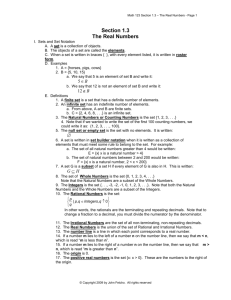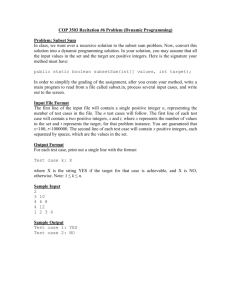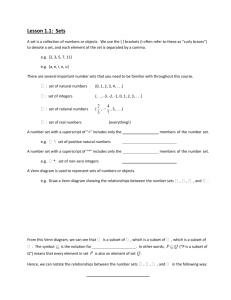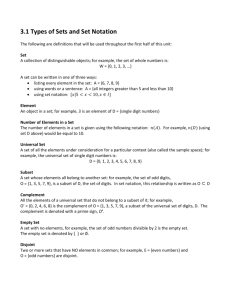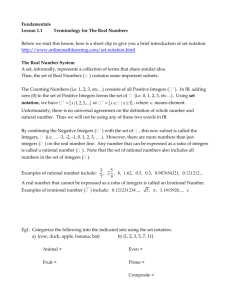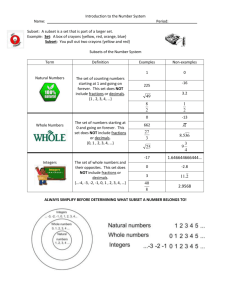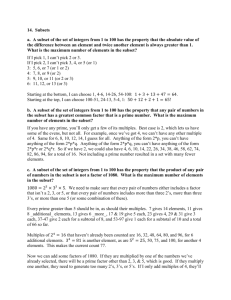Sets, Set Builder Notation & Complements of Sets KEY Sets Set: a
advertisement
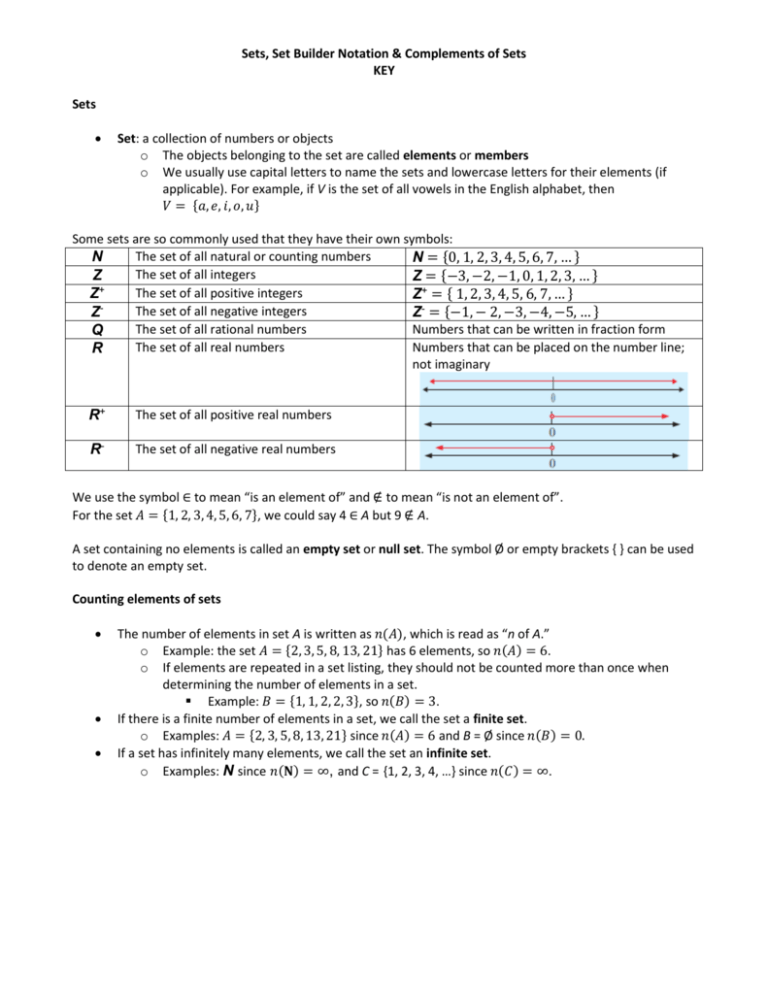
Sets, Set Builder Notation & Complements of Sets
KEY
Sets
Set: a collection of numbers or objects
o The objects belonging to the set are called elements or members
o We usually use capital letters to name the sets and lowercase letters for their elements (if
applicable). For example, if V is the set of all vowels in the English alphabet, then
𝑉 = {𝑎, 𝑒, 𝑖, 𝑜, 𝑢}
Some sets are so commonly used that they have their own symbols:
The set of all natural or counting numbers
N
N = {0, 1, 2, 3, 4, 5, 6, 7, … }
The set of all integers
Z
Z = {−3, −2, −1, 0, 1, 2, 3, … }
+
The set of all positive integers
Z
Z+ = { 1, 2, 3, 4, 5, 6, 7, … }
The set of all negative integers
ZZ- = {−1, − 2, −3, −4, −5, … }
The set of all rational numbers
Numbers that can be written in fraction form
Q
The set of all real numbers
Numbers that can be placed on the number line;
R
not imaginary
R+
The set of all positive real numbers
R-
The set of all negative real numbers
We use the symbol ∈ to mean “is an element of” and ∉ to mean “is not an element of”.
For the set 𝐴 = {1, 2, 3, 4, 5, 6, 7}, we could say 4 ∈ A but 9 ∉ A.
A set containing no elements is called an empty set or null set. The symbol Ø or empty brackets { } can be used
to denote an empty set.
Counting elements of sets
The number of elements in set A is written as 𝑛(𝐴), which is read as “n of A.”
o Example: the set 𝐴 = {2, 3, 5, 8, 13, 21} has 6 elements, so 𝑛(𝐴) = 6.
o If elements are repeated in a set listing, they should not be counted more than once when
determining the number of elements in a set.
Example: 𝐵 = {1, 1, 2, 2, 3}, so 𝑛(𝐵) = 3.
If there is a finite number of elements in a set, we call the set a finite set.
o Examples: 𝐴 = {2, 3, 5, 8, 13, 21} since 𝑛(𝐴) = 6 and B = Ø since 𝑛(𝐵) = 0.
If a set has infinitely many elements, we call the set an infinite set.
o Examples: N since 𝑛(𝐍) = ∞, and C = {1, 2, 3, 4, …} since 𝑛(𝐶) = ∞.
Subsets
Subset: Every element of set A is also an element of set B. Because of this, set A is called a subset of
set B, written in symbols as 𝐴 ⊆ 𝐵.
Proper subset: We say A is a proper subset of B if and only if every element in A is also in B, and there
exists at least one element in B that is not in A. (Essentially, A ≠ B.) This is written in symbols as A ⊂ B.
If A is a proper subset of B, then A is also a subset of B.
Examples:
𝐴 = {1, 2, 3} and 𝐵 = {1, 2, 3, 4}
Yes
No
Yes
No
A ⊆ B?
B ⊆ A?
A ⊂ B?
B ⊂ A?
𝐴 = {8, 9, 10} and 𝐵 = {8, 9, 10}
Yes
Yes
No
No
A ⊆ B?
B ⊆ A?
A ⊂ B?
B ⊂ A?
𝐴 = {4, 8, 15, 16, 23, 42} and 𝐵 = {15, 16}
No
Yes
No
Yes
A ⊆ B?
B ⊆ A?
A ⊂ B?
B ⊂ A?
Intersection & Union
𝑃 ∩ 𝑄 is the intersection of P and Q. This consists of all elements which are in both P and Q.
𝑃 ∪ 𝑄 is the union of P and Q. This consists of all elements which are in either P or Q.
Example: If 𝑃 = {1, 3, 4} and 𝑄 = {2, 3, 5}, then 𝑃 ∩ 𝑄 = {3} and 𝑃 ∪ 𝑄 = {1, 2, 3, 4, 5}.
Disjoint Sets
Two sets are disjoint or mutually exclusive if they have no elements in common. For example 𝑆 = {1, 3, 5, 7, 9}
and 𝑇 = {0, 2, 4, 6, 8} are disjoint because they share no common elements.
Putting it all together… Example. 𝑀 = {2, 3, 5, 7, 8, 9} and 𝑁 = {3, 4, 6, 9, 10}
1. True or false? 4 ∈ M false
2. True or false? 6 ∉ M true
3. List the set 𝑀 ∩ 𝑁. 𝑴 ∩ 𝑵 = {𝟑, 𝟗}
4. List the set 𝑀 ∪ 𝑁. 𝑴 ∪ 𝑵 = {𝟐, 𝟑, 𝟒, 𝟓, 𝟔, 𝟕, 𝟖, 𝟗, 𝟏𝟎}
5. Is M ⊆ N? No
6. Is {9, 6, 3} ⊆ N? Yes
7. Are M and N mutually exclusive? No
Methods of writing sets
There are 3 ways you can write a set:
Word description
A = the set of even natural numbers less than 10
Listing notation
B = {2, 4, 6, 8} or C = {red, green, blue}
Set builder notation
𝐷 = { 𝑥 | 0 ≤ 𝑥 ≤ 5}
The open bracket is read as “the set of all” and the vertical bar is read as “such
that.”
We can abbreviate sets in the listing notation, if applicable, by establishing the pattern of elements included
and using ellipsis points to indicate a continuation of the pattern. For example, we could abbreviate the set of
all letters of the English alphabet, E, as 𝐸 = {𝑎, 𝑏, 𝑐, 𝑑, … , 𝑥, 𝑦, 𝑧} or 𝐸 = {𝑎, 𝑏, 𝑐, 𝑑, 𝑒, … , 𝑧}.
Examples using set builder notation:
1. 𝐷 = {𝑥 | − 2 ≤ 𝑥 ≤ 4, 𝑥 ∈ 𝐙 }
This is read as “the set of all x such that x is an integer between -2 and 4, including -2 and 4.”
We can represent D on a number line as:
D is a finite set, and 𝑛(𝐷) = 7.
2. 𝐸 = {𝑥 | − 2 ≤ 𝑥 < 4, 𝑥 ∈ 𝐑 }
This is read as “the set of all x such that x is a real number between greater than or equal to -2
and less than 4.”
We can represent E on a number line as:
E is an infinite set, and 𝑛(𝐸) = ∞.
Universal Sets
It is important to know what sort of elements are contained in a set. In order to properly define a set, we need
to define the universal set, or all elements of a set. The symbol U is used to represent the universal set under
consideration (be careful not to confuse this with the union symbol, ∪.)
Example. Suppose we are only interested in the natural numbers from 1 to 20. We could write the universal
set as 𝑈 = {𝑥|1 ≤ 𝑥 ≤ 20, 𝑥 ∈ 𝑵}.
Complements of Sets
For any set A within the universal set U, the complement of A, written as A’, is the set of elements of U that
are not elements of A. A’ is read as “A prime.”
Example. If the universal set 𝑈 = {1, 2, 3, 4, 5, 6, 7, 8} and the set 𝐴 = {1, 3, 5, 7, 8}, then the complement of A
is 𝐴′ = {2, 4, 6}.
Three obvious relationships exist connecting A and A’.
1.
𝐴 ∩ 𝐴′ = ∅
2.
𝐴 ∪ 𝐴′ = 𝑈
3.
𝑛(𝐴) + 𝑛(𝐴′ ) = 𝑛(𝑈)
A and A’ have no numbers in common
All elements of A and A’ combined make up U
Example. Find C’ given that:
a. U = {all positive integers} and C = {all even integers}
C’ = {all odd positive integers}
b. 𝐶 = {𝑥 | 𝑥 ≥ 2, 𝑥 ∈ 𝒁} and 𝑈 = 𝒁
𝑪′ = {𝒙 | 𝒙 ≤ 𝟏, 𝒙 ∈ 𝒁} or {𝒙 | 𝒙 < 𝟐, 𝒙 ∈ 𝒁
Example. Suppose 𝑈 = {𝑥 | − 5 ≤ 𝑥 ≤ 5, 𝑥 ∈ 𝒁}, 𝐴 = {𝑥 | 1 ≤ 𝑥 ≤ 4, 𝑥 ∈ 𝒁} and 𝐵 = {𝑥 | − 3 ≤ 𝑥 < 2, 𝑥 ∈
𝒁}. List the elements of the following sets:
{1, 2, 3, 4}
a. A
b. B
{−3, −2, −1, 0, 1}
c. A’
{−5, −4, −3, −2, −1, 0, 5}
d. B’
{−5, −4, 2, 3, 4, 5}
{1}
{−3, −2, −1, 0, 1, 2, 3, 4}
e. 𝐴 ∩ 𝐵
f. 𝐴 ∪ 𝐵
{−3, −2 − 1, 0}
{−5, −4, −3, −2, −1, 0, 2,3, 4, 5}
g. 𝐴′ ∩ 𝐵
h. 𝐴′ ∪ 𝐵′
Example. Suppose U = {positive integers}, P = {multiples of 4 less than 50}, and Q = {multiples of 6 less than 50}.
1. List P and Q.
𝑃 = {4, 8, 12, 16, 20, 24, 28, 32, 36, 40, 44, 48}
𝑄 = {6, 12, 18, 24, 30, 36, 42, 48}
2. Find 𝑃 ∩ 𝑄.
𝑃 ∩ 𝑄 = {12, 24, 36, 48}
3. Find 𝑃 ∪ 𝑄.
𝑃 ∪ 𝑄 = {4, 6, 8, 12, 16, 18, 20, 24, 28, 30, 32, 36, 40, 42, 44, 48}
4. Verify that 𝑛(𝑃 ∪ 𝑄) =
𝑛(𝑃 ∪ 𝑄) = 16 and 𝑛(𝑃) + 𝑛(𝑄) − 𝑛(𝑃 ∩ 𝑄) = 12 + 8 − 4 = 16
𝑛(𝑃) + 𝑛(𝑄) − 𝑛(𝑃 ∩ 𝑄).
